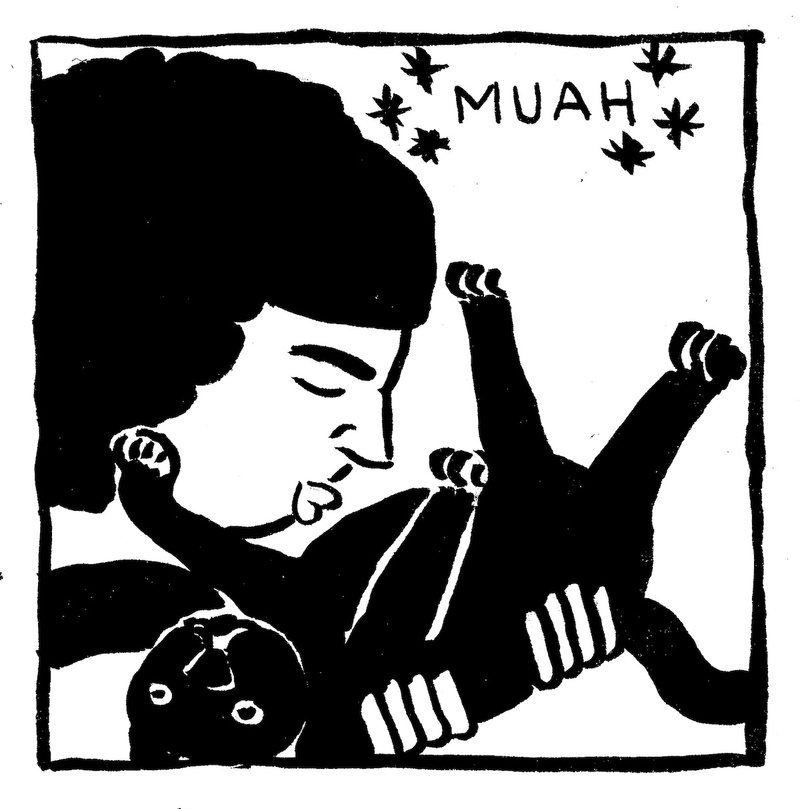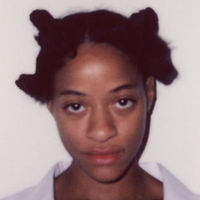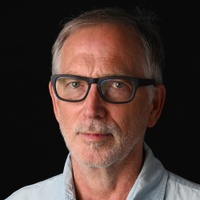On creating work from your own life
Prelude
Jessica Campbell is an interdisciplinary artist originally from Nanaimo, British Columbia. She is the author of three graphic novels, including Rave (Drawn & Quarterly, April 2022), and her work has been exhibited at museums and galleries throughout North America. She is a Visiting Assistant Professor of Art History at Saint Norbert College (De Pere, WI).
Conversation
On creating work from your own life
Artist and humorist Jessica Campbell on putting together a graphic novel, the benefits of moving to a smaller city, and the rewards of making art.
As told to Kerry Cardoza, 2550 words.
Tags: Art, Comics, Education, Process, Identity, Multi-tasking, Mental health, Time management.
Rave is your third book. What’s your process for putting a book together?
It’s changed. The other two books are different from one another because one’s kind of single page, gag images, and the second book was more of a graphic novel narrative. For that book, I had a general outline of what would happen. Then I moved right into thumbnails, kind of story-boarding, but I felt like the pacing in that book was not right. It was too quick. I’d read Nick Drnaso’s book Sabrina and spoken to my friend Anya Davidson, who’s another cartoonist, about a comic she did, called Lovers in the Garden, which is really excellent. Both of them said they wrote scripts.
I decided to copy them and write a script, which I’d been reticent to do because I think that can prioritize the writing over the drawing. The drawing can then become kind of less crucial to the storytelling, which is not something that I wanted because otherwise why work in comics? But it really helped me. Editing comics is very difficult, particularly once the book has been drawn, because you can’t just go back and add a panel in here and there. You have to add in multiple pages and redraw things.
Script writing allowed for this other layer of editing and working out issues like pacing, dialogue, and plot There are other cartoonists like Lynda Barry and Chris Ware who don’t do either of those things. They just put their pen on the paper, maybe have a vague idea of what’s going to happen and start drawing. I think they’re both some of the best working cartoonists today. They’re amazing. But that process just didn’t work for me as well.
I thought the pacing in Rave was great. I was drawn to the layout and the moments where you zoom out and see a larger scene. When you get an idea, how do you know that it makes sense as a book versus something you want to explore in a carpet painting series?
There are certain themes that I’m eternally drawn to, like gendered discrimination. I grew up in this culty kind of Evangelical Church. That’s something that has informed my worldview and life experience a lot. It’s something I’ve tried to address, but this is the first time I’m head-on addressing that world. So, there are these themes that come up across the work, but fundamentally I believe that comics communicate differently than studio work or visual art. You can be a lot more direct in a narrative.
Whereas, if I were working in carpet, the only way I could think to do it—to make an overt statement about an idea—it becomes didactic and not interesting to engage with. I like making things that are a little bit more ambiguous so that people can interpret them, based in part on their own life experience or the material decisions. I could do a narrative in carpet, but then if someone were to read it and then just be done with the piece or kind of get the idea and walk away, that would not feel successful to me.
Did you start working on this book during the pandemic?
I started working on this book in the summer of 2018. I had the seeds of ideas and was writing down plot points. Then I had finished the first 15 pages. I read them at the MCA when I had a solo show there in 2018, 2019. There’s a reading series in Chicago called Zine Not Dead. We did a special edition of that at the museum and I read the first chapter-ish of the book, but the bulk of the work was done during the pandemic.
That was around the same time you moved to Green Bay, right?
Yeah, my husband and I moved to Green Bay in the summer of 2019, because his mom is sick and we came to spend time with her and help out in any way that we can. There was this dislocation of moving here, but I was traveling and seeing my family and we had exhibitions and teaching elsewhere. Then the pandemic hit and we were, as was the rest of the world, stuck inside our homes. I think particularly because we’re here to help out with some immunocompromised people, we were very severe in how isolated we became. We were just so scared of killing Aaron’s parents.
We would order groceries for pickup and not see anyone. And a lot of my exhibitions and teaching got canceled or postponed indefinitely, so I had this time. Working on a book was actually the perfect project because I could just get up and sit at my little desk and draw. Since the publishing industry hasn’t entirely collapsed, I was like, even if COVID is still happening in 2022, which sadly it is, I know that the book will come out anyway and be able to get into people’s hands, unlike exhibitions, which still feel more tenuous.
I was curious how it’s been to be an artist going from a bigger city like Chicago to a much smaller one, but because so many things have been closed, I don’t know if it really feels like it’s sunk in.
It’s a weird experience. I feel really lonely and isolated here. But there are some great people here. One thing that’s been sort of cool for me, I teach at a small university here and because we live in such a relatively small city with few artists, I’ve met many of the artists already. I’m like, okay, I know all six of you. So I’ve been making friends with people outside of the arts. Like some of my colleagues in philosophy and sociology at the college and that’s been cool. I realized that in Chicago, I think 100% of my friends were artists or art writers or curators or involved in the art world in some way, which was awesome, but it’s nice to meet people who are doing other things.

You teach and you had a show last year at Western Exhibitions. You were doing this other work while working on the book. How do you balance all those different projects?
I find it impossible to work on comics and studio work at the same time. It’s just such a different mindset, and so there tend to be big gaps. I had a show at Western Exhibitions in November and I didn’t really start working on that in earnest until the book was done.
I’m in this group show at the [John Michael] Kohler [Arts Center] that opens in April and I’m completely working on that and haven’t drawn a comic for the past few months. I find it really difficult to switch my mindset between different modes of working. In general, even teaching and then going into the studio, my preference would be just to do one thing all day, every day.
Similarly, we sort of talked about this before, how oftentimes artists are making money through these various pockets, like grants or working part-time. How do you avoid burnout when maybe you feel like you need to say yes to a lot of things?
This last semester, I said yes to everything. I was teaching five days a week and then working on exhibitions and I totally burnt out. I felt like I was going to have a meltdown. It’s been really difficult. I think my capacity for dealing with stress or anything that goes wrong has diminished exponentially over the past few years. Handling this family stuff is really hard, and COVID, and politics has been very… I don’t know. I feel like I’m hanging on by a thread. I started taking antidepressants, which I think helps a lot. I think exercise helps a lot, which I have been neglecting during this cold snap, but I don’t know that I’m coping very well, to be honest.
Going back to the book, you talked a little bit about your background and it seems like you have some similarities with the main character Lauren, who’s a Canadian teen growing up in this Evangelical community in the 2000s. What’s it like to draw from your own life when you’re making work?
Something that’s really nice about working in fiction is that I’ve been able to pull from my own personal experiences and vicarious experiences through friends. But I’m not beholden entirely to the truth. I can adjust things, like the character Mariah who’s prominent in the book is not based on one single person, but she’s an amalgam of several people that I know put together. I suppose Lauren, too—it’s not strictly autobiographical. That’s really freeing to be able to combine personal experiences together to make fiction.
There were moments in working on this book where I found that I was mildly traumatized or maybe more than mildly traumatized by my religious upbringing. I have a difficulty now, being exposed to extreme, overt religion…or even anything in the spiritual realm without feeling sick to my stomach. Working on this at times, I was like, “Oh, this is kind of nauseating.” Or I was watching sermons on YouTube to try to get some of the cadence right and vocabulary, because it’s so particular. And it just made me feel nauseous. That was difficult, but it felt important to me to try to capture it as accurately as possible.
Does it feel like you’re working through something or like you’re closing a chapter in some way?
Yeah. It definitely feels like I’m working through something for sure. It’s so funny. This kind of religion dominated the first 18, 20 years of my life in such an intense way that now…what’s it been? I’m 36, so that’s the first half of my life. And the second half of my life, it’s not been as prominent of a facet. I sort of have these sense memories of it…I feel like there’s such a clean break from this intensely religious period to not an intensely religious period, that it’s difficult even to remember some of it. All of my work comes from some personal place.
Do you ever worry about the reaction of people in your life?
Yeah, I’m super worried. I’m only worried about my dad, who’s extremely, extremely religious. That’s the dominating thing in his life. He’s become obsessed with conspiracy theories, especially COVID, but also Trump and [it] has driven this enormous wedge between him and the rest of the family. It’s really painful. I love him a lot. I think he’s a really great, funny, kind, generous person, but it’s become very difficult to have a relationship with him. Our conversations have been basically relegated to talking about the weather, not the climate, but the weather. And dogs, which is cool, I love dogs.
I don’t want him to read the book and yet I feel like he’s the person I made the book for. So it’s difficult. Otherwise the rest of my family, I’m not concerned about them reading it. But, I am deeply freaked out about the idea of my dad seeing it, which he probably will.
When you’re working on a project like this, do you show it to people while you’re working on it? Do you get feedback?
My husband, Aaron Renier, is a cartoonist and I show him my work as I’m working on it. I have a friend, Em Kettner, who’s an artist. She’s a really good friend from grad school, and I sent her the first half of the book. I also sent segments to my publisher as I was working on them. But cartooning happens at such a glacially slow pace that I’ll sit at a desk and spend 10 hours drawing a page of someone silently waiting for the bus. Then it’s hard because I’ve been working on this all day, I want feedback, and I show it to Aaron and he’s like, “Yeah. The book is no different than it was yesterday.”
I’m also protective of getting criticism as I’m in the midst of a project, because it’s really hard for me to convey my vision for what I want it to be in the middle of it. I think it’s impossible often for someone else to step into the room or read the book and understand what I’m seeing in my head. I think the facet of grad school of having people walk in and out of your studio constantly and say like, “What are you making? Why did you make this? Why did you put this color here?” That was not useful to me and has made me not want to let anyone in the studio or see the work in progress. I’m extremely protective of who looks at the work.
What would you say the rewards are of your creative practice? What do you get from making work?
In this book in particular, I want to convey the experience of what it felt like to be raised in this really conservative religious environment…an extremely judgmental, hypocritical kind of space, that I think, specifically with women, devalues them as human beings. They’re not seen as full human beings. This is definitely my experience of being raised in that environment—that I was not a full human being and the reason I existed was to be a servant to men. That’s what I was literally told in church. I want to convey to people what this feels like. Maybe help generate a little more empathy in the world for other people.
It’s hard for me not to feel sometimes really polarized and hateful because of the religious and political landscape in the United States—like half of the country is my enemy—but I want to not feel that way. I want other people to be a little more empathetic and caring to their fellow person. I also think about people who are undergoing experiences like this, where they’re being marginalized and judged and on the receiving end of really hateful rhetoric coming from their community. I want to make something that maybe makes them feel a little bit less alone. That’s important to me.
I think filtering the world through art is a way for me to express things that are ineffable or inexpressible otherwise. It feels important to my own mental health or way of processing the world. And I feel like I get some agency. I felt like I was stripped of agency throughout my childhood and throughout a lot of my life, I’ve been stripped of a lot of agency through shitty jobs and just places I’ve been where I don’t have a voice. And I feel like making this book gives me some power back or some agency back.
Jessica Campbell Recommends:
Samantha Irby’s Wow, No Thank You
The art of William J. O’Brien
Cougar Creek, British Columbia
- Name
- Jessica Campbell
- Vocation
- artist, graphic novelist, humorist
Some Things
Pagination



